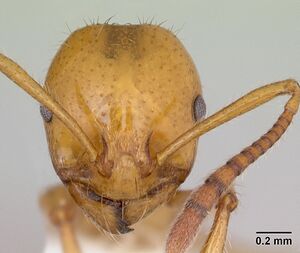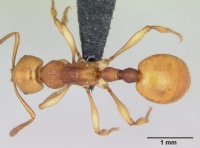Syllophopsis aureorugosa
| Syllophopsis aureorugosa | |
|---|---|

| |
| Scientific classification | |
| Kingdom: | Animalia |
| Phylum: | Arthropoda |
| Class: | Insecta |
| Order: | Hymenoptera |
| Family: | Formicidae |
| Subfamily: | Myrmicinae |
| Tribe: | Solenopsidini |
| Genus: | Syllophopsis |
| Species: | S. aureorugosa |
| Binomial name | |
| Syllophopsis aureorugosa (Heterick, 2006) | |
A nest series has been collected from soil below tree roots. Individual workers have been taken from sifted leaf litter, and in pitfall, Winkler and yellow pan traps.
Identification
Heterick (2006) - Syllophopsis aureorugosum is one of two very large members of the Syllophopsis hildebrandti group with a restricted range in far north-eastern Madagascar. This ant, along with Syllophopsis infusca, is known only from a small number of workers. Because their ranges overlap, and they are clearly closely related, it is tempting to combine the two forms. However, they appear to represent distinct species, not only because there exist no examples of intermediate color, but because there are subtle but consistent differences in the morphometrics pertaining to the antennal scape (i.e., the SL for S. aureorugosum is 1.02–1.10mm, while that for S. infusca is 0.86–1.00mm, and their respective SI’s are 98–103 and 92–99).
Keys including this Species
Distribution
Latitudinal Distribution Pattern
Latitudinal Range: -14.43597222° to -16.530516°.
| North Temperate |
North Subtropical |
Tropical | South Subtropical |
South Temperate |
- Source: AntMaps
Distribution based on Regional Taxon Lists
Malagasy Region: Madagascar (type locality).
Distribution based on AntMaps
Distribution based on AntWeb specimens
Check data from AntWeb
Countries Occupied
| Number of countries occupied by this species based on AntWiki Regional Taxon Lists. In general, fewer countries occupied indicates a narrower range, while more countries indicates a more widespread species. |

|
Estimated Abundance
| Relative abundance based on number of AntMaps records per species (this species within the purple bar). Fewer records (to the left) indicates a less abundant/encountered species while more records (to the right) indicates more abundant/encountered species. |

|
Habitat
Rainforest
Biology
Castes
Worker
Images from AntWeb
   
| |
| Holotype of Syllophopsis aureorugosa. Worker. Specimen code casent0172919. Photographer April Nobile, uploaded by California Academy of Sciences. | Owned by CAS, San Francisco, CA, USA. |
Nomenclature
The following information is derived from Barry Bolton's Online Catalogue of the Ants of the World.
- aureorugosa. Monomorium aureorugosum Heterick, 2006: 160, figs. 28, 73, 74 (w.) MADAGASCAR.
- Type-material: holotype worker, 37 paratype workers.
- Type-locality: holotype Madagascar: Prov. Toamasina, 6.9 km. NE Ambanizana, 825 m., 15°34’S, 50°00’E, 2.xii.1993, #976(14)-19, sifted litter (leaf mold, rotten wood), rainforest (B.L. Fisher); paratypes with same data.
- Type-depositories: CASC (holotype); ANIC, BMNH, CASC, MCZC (paratypes).
- Combination in Syllophopsis: Ward, et al. 2015: 73.
- Distribution: Madagascar.
Unless otherwise noted the text for the remainder of this section is reported from the publication that includes the original description.
Description
Worker
Holotype: HML 3.61 HL 1.12 HW 1.02 CeI 91 SL 1.02 SI 100 PW 0.75.
HML 3.52–3.90 HL 1.10–1.20 HW 1.00–1.09 CeI 89–93 SL 1.02–1.07 SI 98–103 PW 0.74–0.82 (n=13).
HEAD: Head oval; vertex planar or weakly concave; frons shining and smooth except for piliferous pits; pilosity of frons a mixture of well-spaced, distinctly longer erect and semi-erect setae interspersed with shorter decumbent setae or setulae. Eye moderate, eye width 1–1.5× greatest width of antennal scape; (in full-face view) eyes set above midpoint of head capsule; (viewed in profile) eyes set anteriad of midline of head capsule; eye elliptical, curvature of inner eye margin may be more pronounced than that of its outer margin. Antennal segments 12; antennal club not clearly defined. Clypeal carinae indicated by multiple weak ridges; anteromedian clypeal margin broadly convex; paraclypeal setae short and thickened, not reaching basal margin of closed mandibles; posteromedian clypeal margin approximately level with antennal fossae. Anterior tentorial pits situated nearer antennal fossae than mandibular insertions. Frontal lobes sinuate, divergent posteriad. Psammophore absent. Palp formula 2,2. Mandibular teeth five; mandibles triangular and smooth (except for piliferous pits); masticatory margin of mandibles approximately vertical or weakly oblique; basal tooth approximately same size as t4 (five teeth present), or, smaller than t4 (five teeth present).
MESOSOMA: Promesonotum shining, with whorls of rugae on sides of promesonotum, these becoming longitudinal on dorsum; (viewed in profile) promesonotum broadly convex; promesonotal setae greater than twelve; standing promesonotal setae a mixture of well-spaced, distinctly longer, erect and semi-erect setae which are curved distally and often paired, interspersed with much shorter, incurved, decumbent setae; appressed promesonotal setulae few, mainly on sides of promesonotum. Metanotal groove absent. Propodeum shining, with strong, transverse rugae dorsally, laterally and on declivitous face; propodeal dorsum flat throughout most of its length; propodeum always smoothly rounded; standing propodeal setae consisting of two or more prominent pairs anteriad, often with another pair of prominent setae posteriad, and other smaller setae on/around dorsal and declivitous surfaces of propodeum; appressed propodeal setulae very sparse or absent; propodeal spiracle equidistant from metanotal groove and declivitous face of propodeum. Vestibule of propodeal spiracle absent or not visible. Propodeal lobes present as blunt-angled flanges; Petiolar spiracle laterodorsal and situated slightly anteriad of petiolar node; node (viewed in profile) broad and thick, with short vertex anteriad, node sloping posteriad; appearance of node transversely rugose, shining between sculpture; ratio of greatest node breadth (viewed from front) to greatest node width (viewed in profile) about 1:1.
PETIOLE AND POSTPETIOLE: Anteroventral petiolar process present as a thin flange tapering posteriad to absent or vestigial; ventral petiolar lobe absent; height ratio of petiole to postpetiole between 4:3 and 1:1; height–length ratio of postpetiole about 1:1; postpetiole strongly rugose; postpetiolar sternite not depressed at midpoint, its anterior end an inconspicuous lip or small carina.
GASTER: Pilosity of first gastral tergite consisting of well-spaced, erect and semi-erect setae interspersed with a few appressed setulae.
GENERAL CHARACTERS: Color head, gaster and appendages yellow, mesosoma reddish-orange. Worker caste monomorphic.
Type Material
Holotype: worker, Prov. Toamasina, 6.9 km NE Ambanizana, 15º34′S, 50º00′E 825m 2.xii.1993 B.L. Fisher #976(41)–19/sifted litter (leaf mold, rotten wood) rainforest (California Academy of Sciences). Paratypes: Prov. Toamasina (specimens with same collection data as holotype): 1worker (Australian National Insect Collection) 12 workers (The Natural History Museum); 1 worker (CAS) 23 workers (Museum of Comparative Zoology).
Etymology
Latin ‘aureus’ (‘golden’) + ‘rugosus’ (‘wrinkled’)
References
- Akbar, S.A., Bharti, H., Kanturski, M., Wachkoo, A.A. 2021. First record of the myrmicine ant genus Syllophopsis Santschi, 1915 (Hymenoptera: Formicidae) from India with description of a new species. Zootaxa 4985: 403-413 (doi:10.11646/zootaxa.4985.3.7).
- Heterick, B.E. 2006. A revision of the Malagasy ants belonging to genus Monomorium Mayr, 1855. Proceedings of the California Academy of Sciences. 57:69-202.
- Ward, P.S., Brady, S.G., Fisher, B.L., Schultz, T.R. 2015. The evolution of myrmicine ants: phylogeny and biogeography of a hyperdiverse ant clade (Hymenoptera: Formicidae). Systematic Entomology 40: 61–81 (doi:10.1111/syen.12090).
References based on Global Ant Biodiversity Informatics
- Heterick B. 2006. A Revision of the Malagasy Ants Belonging to Genus Monomorium Mayr, 1855 (Hymenoptera: Formicidae). Proceeding of the California Academy of Sciences (PCAS) 57: 69-202

